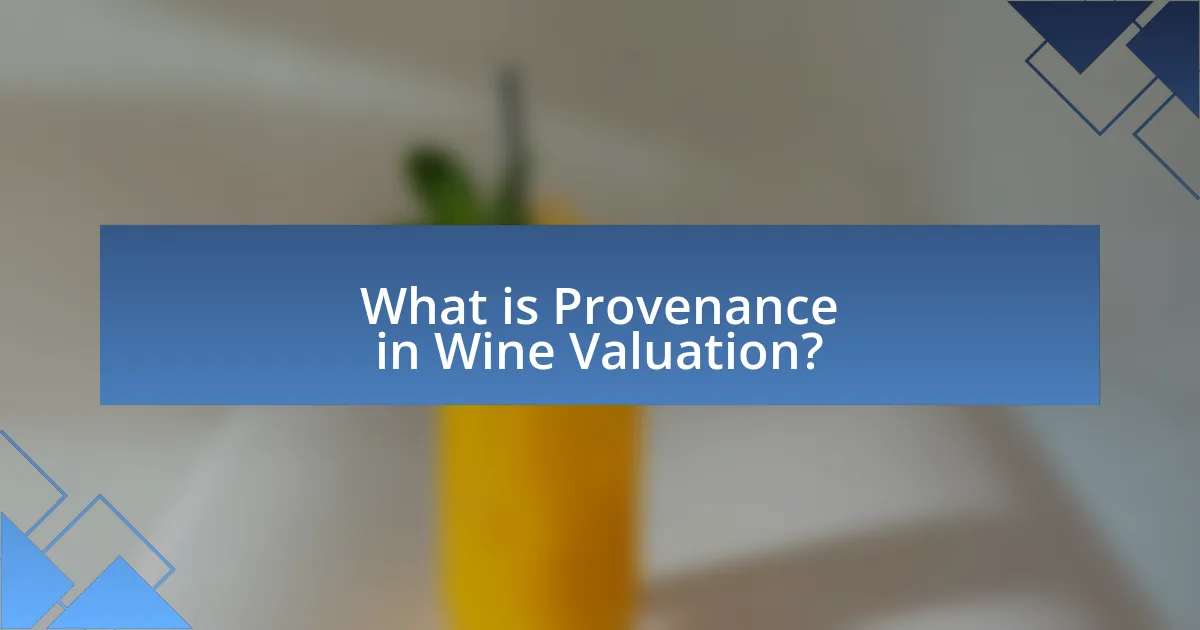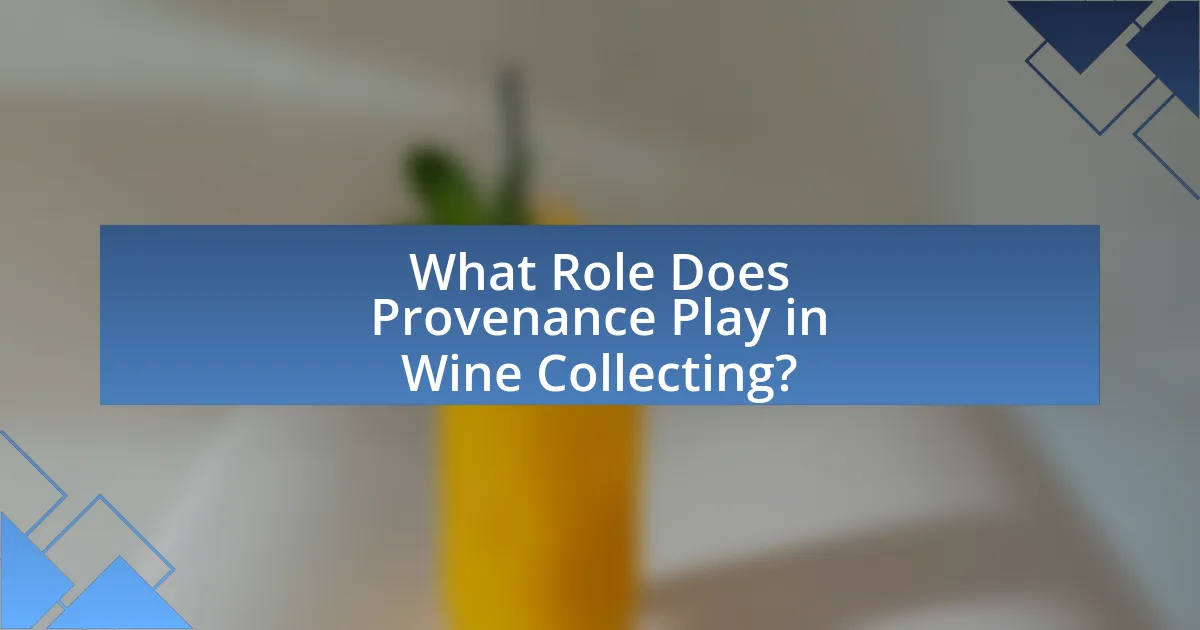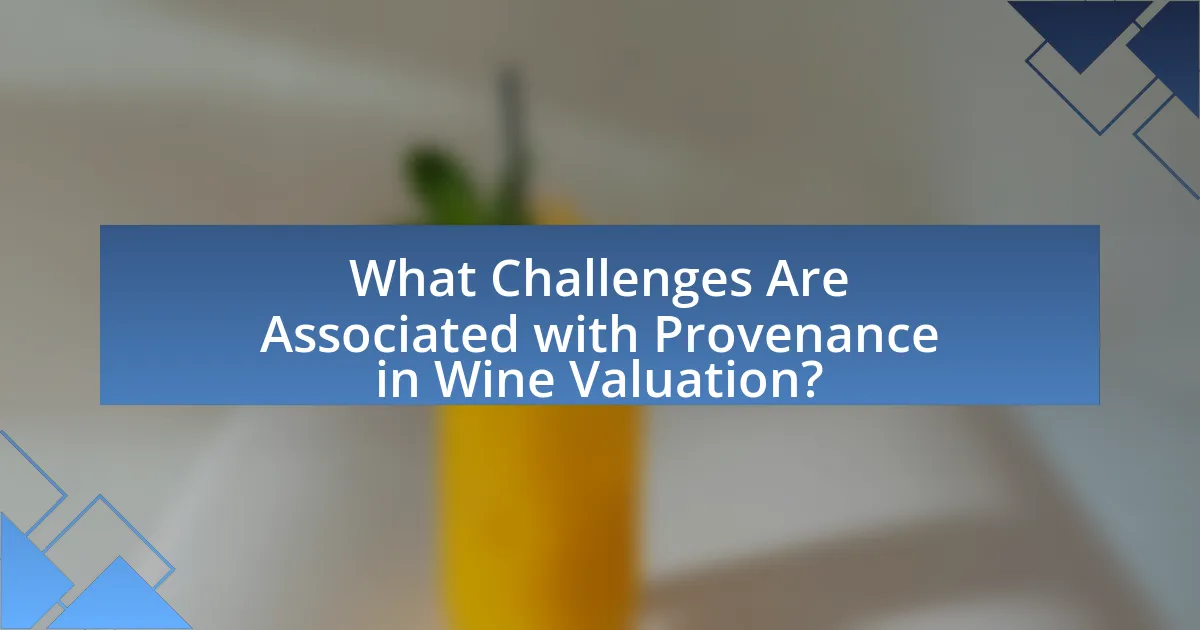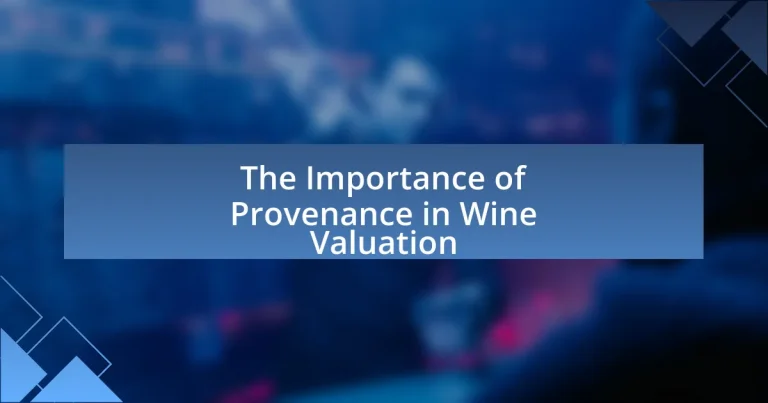Provenance in wine valuation refers to the documented history of a wine’s origin, ownership, and storage conditions, which significantly impacts its authenticity, quality, and market value. Key factors influencing provenance include the wine’s origin, vineyard practices, vintage, and storage conditions. Wines with well-documented provenance, particularly from reputable vineyards, tend to command higher prices due to their perceived reliability and desirability among collectors. The article explores the importance of provenance in wine valuation, the challenges associated with verifying it, and the role of technology in enhancing provenance tracking, ultimately highlighting its critical influence on wine investment and auction prices.

What is Provenance in Wine Valuation?
Provenance in wine valuation refers to the documented history of a wine’s origin, ownership, and storage conditions. This information is critical because it influences the wine’s authenticity, quality, and market value. Provenance can include details such as the vineyard where the grapes were grown, the winemaker’s reputation, and the conditions under which the wine was stored and transported. For instance, wines with a well-documented provenance, such as those from renowned estates or with a history of proper storage, typically command higher prices in the market.
Why is Provenance Important in Wine Valuation?
Provenance is crucial in wine valuation because it establishes the history and authenticity of a wine, significantly influencing its market value. A wine’s provenance includes details such as its origin, ownership history, and storage conditions, which can affect its perceived quality and rarity. For instance, wines from renowned vineyards or those with a documented history of proper storage command higher prices due to their assurance of quality and authenticity. Additionally, auction houses and collectors often rely on provenance to verify a wine’s legitimacy, as wines with questionable or unknown provenance may be deemed less valuable or even counterfeit.
What factors contribute to a wine’s provenance?
A wine’s provenance is influenced by several key factors, including its origin, vineyard practices, vintage, and storage conditions. The origin refers to the specific region and vineyard where the grapes are grown, which can significantly affect the wine’s characteristics and reputation. Vineyard practices encompass the methods used in cultivation and harvesting, such as organic farming or traditional techniques, which can enhance quality and authenticity. The vintage indicates the year the grapes were harvested, with certain years being recognized for exceptional weather conditions that yield superior wines. Lastly, storage conditions, including temperature, humidity, and light exposure, play a crucial role in maintaining the wine’s quality over time. These factors collectively establish a wine’s provenance, impacting its valuation and desirability in the market.
How does provenance influence a wine’s market value?
Provenance significantly influences a wine’s market value by establishing its authenticity, quality, and historical significance. Wines with well-documented provenance, such as those from reputable vineyards or notable vintages, command higher prices due to their perceived reliability and desirability among collectors. For instance, a bottle of Bordeaux from a renowned estate with a clear ownership history can sell for thousands of dollars, while a similar wine without provenance may only fetch a fraction of that price. Provenance also affects market demand; wines with prestigious origins are often sought after in auctions, further driving up their value.
How is Provenance Established in the Wine Industry?
Provenance in the wine industry is established through a combination of documentation, traceability, and verification processes. This includes the use of certificates of origin, vineyard records, and detailed production logs that track the wine from grape to bottle. For instance, reputable wineries maintain meticulous records of their harvests, fermentation processes, and bottling dates, which are crucial for establishing authenticity. Additionally, third-party organizations often conduct audits and provide certifications that further validate the wine’s origin. The presence of these records and certifications is essential, as they help to prevent fraud and ensure that consumers can trust the quality and authenticity of the wine they purchase.
What documentation is necessary to verify a wine’s provenance?
To verify a wine’s provenance, essential documentation includes the certificate of authenticity, shipping records, and historical ownership records. The certificate of authenticity, often issued by the producer or a recognized authority, confirms the wine’s origin and quality. Shipping records provide a traceable path from the vineyard to the retailer, ensuring transparency in the wine’s journey. Historical ownership records detail previous custodians of the wine, which can enhance its value and verify its authenticity. Together, these documents create a comprehensive verification process that substantiates the wine’s provenance.
How do producers and retailers ensure the authenticity of provenance?
Producers and retailers ensure the authenticity of provenance through rigorous documentation and traceability systems. These systems often include detailed records of the wine’s origin, production methods, and transportation, which are verified by third-party certifications. For instance, many wineries utilize blockchain technology to create an immutable record of each bottle’s journey from vineyard to consumer, enhancing transparency and trust. Additionally, adherence to regional regulations and certifications, such as those from the Appellation d’Origine Contrôlée (AOC) in France, provides further validation of the wine’s provenance. This combination of technology and regulatory compliance helps to substantiate claims of authenticity in the wine industry.

What Role Does Provenance Play in Wine Collecting?
Provenance plays a critical role in wine collecting by establishing the history and authenticity of a wine bottle, which directly influences its value. A well-documented provenance assures collectors that the wine has been stored and handled properly, reducing the risk of fraud and spoilage. For instance, wines with a traceable history from reputable vineyards or collectors often command higher prices at auctions, as seen in the record-breaking sale of a 1945 Romanee-Conti, which fetched over $558,000 due to its impeccable provenance. Thus, provenance not only enhances the desirability of a wine but also serves as a key factor in its valuation within the market.
How does Provenance Affect Wine Investment Decisions?
Provenance significantly influences wine investment decisions by establishing the authenticity and quality of the wine. Investors prioritize wines with documented histories, as this information assures them of the wine’s origin, storage conditions, and overall integrity. For instance, wines from reputable vineyards or those with a traceable history of ownership tend to command higher prices in the market. A study by Liv-ex, a global marketplace for fine wine, indicates that wines with strong provenance can appreciate in value by up to 20% more than those without. This correlation between provenance and value underscores its critical role in guiding investment choices in the wine sector.
What are the risks of investing in wines with unclear provenance?
Investing in wines with unclear provenance poses significant risks, primarily including the potential for counterfeit products and diminished resale value. Wines lacking verified history may be misrepresented, leading to financial loss when the true quality or authenticity is revealed. According to a report by the Wine Institute, approximately 20% of fine wines sold at auction are believed to be counterfeit, underscoring the importance of provenance in ensuring authenticity. Additionally, wines without clear provenance may not appreciate in value as expected, as collectors and investors often prioritize verifiable history when making purchasing decisions. This lack of demand can result in lower market prices, further increasing the financial risk associated with such investments.
How can collectors assess the provenance of their wines?
Collectors can assess the provenance of their wines by verifying the wine’s history, including its origin, ownership, and storage conditions. Provenance can be established through documentation such as purchase receipts, auction records, and certificates of authenticity, which provide a traceable history of the wine. Additionally, reputable wine merchants and auction houses often provide detailed provenance reports that include information about the wine’s previous owners and storage environments, which are critical for determining its quality and value. Collectors should also consider the reputation of the producer and the vineyard, as wines from well-known estates typically have more reliable provenance.
What Impact Does Provenance Have on Wine Auctions?
Provenance significantly impacts wine auctions by influencing the perceived value and desirability of the wine. Wines with documented and reputable provenance often command higher prices due to buyer confidence in their authenticity and quality. For instance, a study by Sotheby’s indicated that wines with strong provenance can sell for up to 50% more than similar wines without verifiable history. This is because provenance assures collectors that the wine has been stored properly and has not been tampered with, thereby enhancing its investment potential.
How do auction houses verify provenance before selling wines?
Auction houses verify provenance before selling wines through a combination of documentation review, expert authentication, and historical tracking. They examine original purchase receipts, storage records, and any certificates of authenticity to establish a wine’s history. Additionally, specialists in wine appraisal assess the wine’s condition and confirm its origin, often referencing established databases and records that track the wine’s journey from vineyard to auction. This meticulous process ensures that the wines are genuine and have a verifiable history, which is crucial for maintaining their value in the market.
What are the implications of provenance on auction prices?
Provenance significantly influences auction prices by establishing the authenticity and history of a wine, which directly affects its perceived value. Wines with well-documented provenance, such as previous ownership by notable collectors or consistent storage conditions, tend to command higher prices at auction. For instance, a study by Sotheby’s in 2020 indicated that wines with verified provenance sold for up to 30% more than those without. This correlation arises because buyers are willing to pay a premium for assurance regarding the quality and authenticity of the wine, reducing the risk associated with counterfeit products.

What Challenges Are Associated with Provenance in Wine Valuation?
Challenges associated with provenance in wine valuation include the difficulty in verifying the authenticity of a wine’s history, the lack of standardized documentation, and the potential for fraud. Authenticity verification is complicated by the absence of universally accepted tracking systems, making it hard to trace a wine’s journey from vineyard to consumer. Additionally, inconsistent documentation practices across different regions and producers can lead to gaps in provenance records. Fraudulent activities, such as counterfeiting, further undermine trust in provenance claims, as evidenced by high-profile cases like the 2008 scandal involving counterfeit wines sold at auction. These challenges collectively hinder accurate wine valuation and can significantly impact market prices.
What Common Issues Arise in Provenance Verification?
Common issues in provenance verification include lack of reliable documentation, difficulty in tracing the history of a product, and the potential for fraudulent claims. Reliable documentation is often missing or incomplete, making it challenging to establish a product’s authenticity. Additionally, tracing the history of wine can be complicated due to multiple ownership changes and inadequate record-keeping practices. Fraudulent claims can arise from counterfeit labels or falsified records, undermining trust in the provenance of the wine. These issues highlight the complexities involved in ensuring accurate provenance verification in wine valuation.
How can counterfeit wines affect provenance claims?
Counterfeit wines significantly undermine provenance claims by creating false narratives about a wine’s origin, history, and authenticity. Provenance, which refers to the documented history of a wine’s ownership and production, relies on accurate information to establish value and trust among consumers and collectors. When counterfeit wines enter the market, they distort this historical record, leading to misattributed value and potential financial loss for buyers. For instance, a study by the University of California, Davis, highlights that counterfeit wines can sell for up to 70% less than their authentic counterparts, illustrating the economic impact of compromised provenance.
What role do technology and innovation play in provenance tracking?
Technology and innovation are crucial in provenance tracking as they enhance transparency and accuracy in the supply chain. Advanced technologies such as blockchain provide immutable records of a product’s journey, ensuring that each transaction is securely documented and easily verifiable. For instance, IBM’s Food Trust blockchain has been utilized in the food industry to trace the origin of products, demonstrating how technology can effectively track provenance. Additionally, innovations like IoT devices enable real-time monitoring of environmental conditions during transportation, further ensuring the integrity of products like wine. These technological advancements not only improve consumer trust but also facilitate compliance with regulatory standards, making provenance tracking more reliable and efficient.
How Can Wine Enthusiasts Ensure Proper Provenance?
Wine enthusiasts can ensure proper provenance by sourcing wines from reputable dealers and verifying the wine’s history through documentation. Reputable dealers often provide certificates of authenticity, which detail the wine’s origin, storage conditions, and previous ownership. Additionally, enthusiasts should research the wine’s vintage and producer, as established wineries typically maintain records that can confirm the wine’s journey from vineyard to bottle. Provenance is crucial because it directly impacts a wine’s value; for instance, wines with well-documented histories often command higher prices in the market.
What best practices should collectors follow to maintain provenance?
Collectors should maintain provenance by meticulously documenting the history of each wine bottle, including its origin, ownership, and any relevant transactions. This practice ensures that the wine’s authenticity and value are preserved over time. Collectors should also retain original purchase receipts, certificates of authenticity, and any correspondence related to the wine’s acquisition. Additionally, maintaining a detailed inventory that includes storage conditions and any changes in ownership further supports the wine’s provenance. Provenance is critical in wine valuation, as wines with well-documented histories often command higher prices in the market, reflecting their authenticity and quality.
How can consumers educate themselves about provenance in wine?
Consumers can educate themselves about provenance in wine by researching the wine’s origin, vineyard practices, and historical context. They can utilize resources such as wine guides, reputable websites, and apps that provide detailed information about specific wines, including their production methods and regions. Additionally, attending wine tastings and seminars can enhance understanding, as these events often feature experts who discuss provenance. Engaging with wine communities, both online and offline, allows consumers to share knowledge and experiences related to wine provenance.
What Are the Future Trends in Provenance and Wine Valuation?
Future trends in provenance and wine valuation include the increasing use of blockchain technology for tracking wine origins and enhancing transparency. Blockchain provides a secure, immutable ledger that allows consumers and collectors to verify the authenticity and history of a wine, thereby increasing its market value. Additionally, the rise of artificial intelligence and machine learning in data analysis is expected to refine valuation models by incorporating a wider range of variables, such as climate conditions and historical pricing trends. According to a report by the International Organisation of Vine and Wine, the global wine market is projected to grow, emphasizing the need for reliable provenance to maintain consumer trust and investment value.
How might blockchain technology influence wine provenance?
Blockchain technology can significantly enhance wine provenance by providing a secure, immutable ledger that records every transaction and movement of a wine bottle from vineyard to consumer. This transparency allows stakeholders, including producers, distributors, and consumers, to verify the authenticity and history of the wine, reducing the risk of fraud and misrepresentation. For instance, a study by the University of California, Davis, highlights that blockchain can track the entire supply chain, ensuring that each bottle’s origin, production methods, and storage conditions are documented and accessible. This level of traceability not only boosts consumer confidence but also adds value to the wine, as provenance is a critical factor in wine valuation.
What emerging practices are being adopted for provenance verification?
Emerging practices for provenance verification in wine valuation include the use of blockchain technology, which provides a secure and immutable ledger for tracking the history of wine from vineyard to consumer. This technology enhances transparency and trust by allowing stakeholders to access verified information about the wine’s origin, production methods, and ownership history. Additionally, advanced data analytics and machine learning algorithms are being employed to analyze historical sales data and detect patterns that may indicate authenticity or fraud. These practices are supported by industry initiatives, such as the Wine Origin Protocol, which aims to standardize provenance verification processes and improve consumer confidence in wine authenticity.


